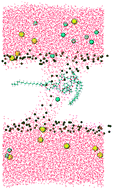The water-channel forming ability of heptapeptide-based anion channels: insights from molecular dynamics simulations
Abstract
Molecular dynamics simulations were performed to gain insight into the channel-forming capabilities of the SCMTR class of anion channels. These results support pore formation by the experimentally predicted single-surface dimeric SCMTR configuration. Simulated currents of 11.1 pA and 3.7 pA were reported for simulations involving a charge imbalance on either side of the bilayer and simulations where an electric field is applied, respectively. Stable water-channels were formed; these began from the SCMTR and extended to the opposing face. Removal of the driving force within the charge separation simulation was found to close the pore within a 10 ns simulation. As predicted, opposing face lipid head-group rearrangement was found to assist in the stabilization of the water-channel. Furthermore, these results suggest that the SCMTR molecules may help thin the bilayer by moving deeper into its surface and, thereby, helping to stabilize the water-channel. These results confirm that the proposed dimeric insertion model is sufficient to stabilize a channel, while providing atomistic insight into the channel's function.


 Please wait while we load your content...
Please wait while we load your content...